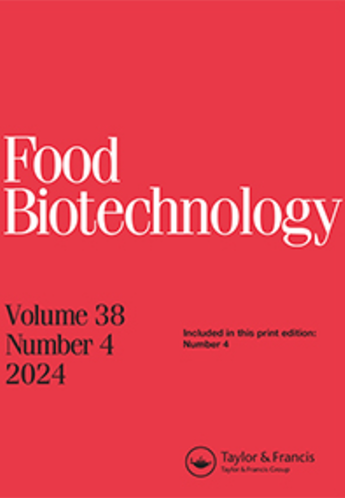浸泡和发芽条件对发芽糙米γ-氨基丁酸及其基因表达的影响
IF 1.6
4区 农林科学
Q4 BIOTECHNOLOGY & APPLIED MICROBIOLOGY
引用次数: 13
摘要
摘要对四个色素陆地小种(Madew Zag-1、Madew Zag-2、Tangdhar Zag和Karnah Zag)和一个高产品种(cv.Jhelum)进行了发芽生产富含γ-氨基丁酸(GABA)糙米的试验。采用中央复合材料旋转设计来确定发芽条件,即浸泡时间(h)、发芽时间(小时)、发芽温度(°C)和相对湿度(%)对GABA含量的影响。所建立的回归模型具有高度显著性(P<.0001)和高决定系数(R2=0.98)。获得的最佳条件为浸泡时间:5.76小时;发芽时间:40h,发芽温度:35°C。还研究了三种谷氨酸脱羧酶cDNA在基因型之间的遗传变异;OsGAD1、OsGAD2和OsGAD3。发芽过程中GABA合成量最大的是Jhelum(48.18 mg/100 g),其次是Tangdhar Zag(44.40 mg/100 g。OsGAD3的基因表达在Jhelum和Tangdhar Zag中上调幅度最大,分别为22.368和19.472倍。本文章由计算机程序翻译,如有差异,请以英文原文为准。
Effect of soaking and germination conditions on γ-aminobutyric acid and gene expression in germinated brown rice
ABSTRACT Four pigmented land races (Madew Zag-1, Madew Zag-2, Tangdhar Zag and Karnah Zag) and one high yielding variety (cv. Jhelum) were tested for production of γ-aminobutyric acid (GABA) rich brown rice through germination. Central composite rotatable design was used to determine the effect of germination conditions, i.e., soaking time (h), germination time (h), germination temperature (°C), and relative humidity (%) on GABA content. Regression model developed was highly significant (P < .0001) with high coefficient of determination (R2 = 0.98). The optimized conditions obtained were soaking time: 5.76 h; germination time: 40 h, and germination temperature: 35°C. The genetic variation among genotypes was also studied with respect to three glutamate decarboxylase cDNAs; OsGAD1, OsGAD2, and OsGAD3. The maximum GABA synthesis during germination was recorded in Jhelum (48.18 mg/100 g) followed by Tangdhar Zag (44.40 mg/100 g). Gene expression of OsGAD3 was also upregulated maximum in Jhelum followed by Tangdhar Zag with a fold change of 22.368 and 19.472, respectively.
求助全文
通过发布文献求助,成功后即可免费获取论文全文。
去求助
来源期刊

Food Biotechnology
工程技术-生物工程与应用微生物
CiteScore
3.80
自引率
0.00%
发文量
15
审稿时长
>12 weeks
期刊介绍:
Food Biotechnology is an international, peer-reviewed journal that is focused on current and emerging developments and applications of modern genetics, enzymatic, metabolic and systems-based biochemical processes in food and food-related biological systems. The goal is to help produce and improve foods, food ingredients, and functional foods at the processing stage and beyond agricultural production.
Other areas of strong interest are microbial and fermentation-based metabolic processing to improve foods, food microbiomes for health, metabolic basis for food ingredients with health benefits, molecular and metabolic approaches to functional foods, and biochemical processes for food waste remediation. In addition, articles addressing the topics of modern molecular, metabolic and biochemical approaches to improving food safety and quality are also published.
Researchers in agriculture, food science and nutrition, including food and biotechnology consultants around the world will benefit from the research published in Food Biotechnology. The published research and reviews can be utilized to further educational and research programs and may also be applied to food quality and value added processing challenges, which are continuously evolving and expanding based upon the peer reviewed research conducted and published in the journal.
 求助内容:
求助内容: 应助结果提醒方式:
应助结果提醒方式:


